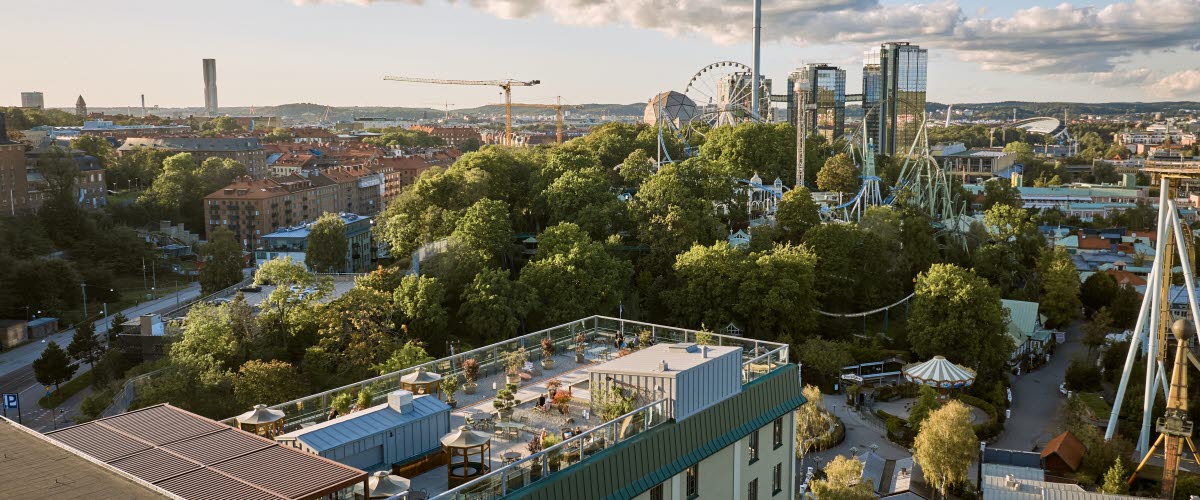5 things to do in Gothenburg and beyond
Situated on Sweden’s glorious west coast, Gothenburg is a vibrant fusion of culture and natural beauty. As the world’s most sustainable destination for six years running, the city offers a host of eco-friendly activities for locals and visitors.
Gothenburg and West Sweden has a great public transport network and a choice of ticket options that make it the obvious choice for getting anywhere in the city and around the region. Research your options and plan your trips on the Västtrafik website or in the app ToGo. You can get to everything mentioned here by public transport from Gothenburg central station.
1. The city: Green spaces and urban life
We start our explorations with a city walk. Gothenburg’s commitment to nature and sustainability is evident in its lush parks and green spaces, such as Trädgårdsföreningen (The Garden Society of Gothenburg), Kungsparken, and Botaniska, (The Gothenburg Botanical Garden).
Gothenburg’s thriving culinary scene emphasizes locally sourced, organic ingredients and sustainable practices. Restaurants like Vrå, Restaurang Familjen, and Restaurang Svinn serve exquisite meals, and for beer enthusiasts the cherry on the cake is the city’s booming craft beer industry with over 40 microbreweries helping West Sweden to quench its thirst.
For more tips, accommodation, and attractions in Gothenburg, visit goteborg.com.
2. The archipelago: Escape from the hustle and bustle
Photographer: Happy Visuals / Studiografen
Gothenburg’s glittering archipelago is just one part of the chain of more than 8,000 islands and islets that stretches along the coast of Bohuslän all the way to Norway, and it offers a refreshing escape from the city.
In the summer it is a playground of blue seas, sunshine and shining white houses, in colder months the granite rocks and misty skies offer a different kind of quiet beauty and the huddled houses become cosy retreats.
The Southern Archipelago includes the islands Styrsö, Vrångö and Donsö, where the small fishing villages offer a glimpse into Swedish coastal life and a taste of the freshest seafood from popular restaurants like Isbolaget (on Donsö) and Café Öbergska (on Styrsö).
Always worth a visit is the enchanting island of Hönö, a happening place all year round and host to excellent restaurants, cafés, hotels, and a collection of gorgeous small shops and boutiques.
- Accommodation tips: Skärgårdshotellet Hönö, Isbolaget Donsö, Kajkanten Vrångö
3. The historical countryside: Discover Sweden’s storied past
Experience some Swedish history set in beautiful surroundings. Gunnebo House and Gardens is one of Scandinavia’s best-preserved 18th-century estates and just 20 minutes from Gothenburg city centre. With guided tours and events held year-round, visitors can immerse themselves in the opulent lifestyle of the wealthy merchant John Hall and his family.
- Top tip: Make sure to find time for lunch or Swedish Fika at the restaurant at Gunnebo
Equally captivating is Råda Manor, a beautifully preserved estate and recently restored manor house, dating back to medieval times. Both houses have kitchen gardens that supply fresh produce to their restaurants and inspire visitors with ideas for their own gardens.
Part of West Sweden’s industrial heritage is beautifully showcased at sites like Nääs Fabriker in the beautifully preserved village of Tollered, a former textile mill turned into a hotel, spa and design gallery, or Spinneriet in Lindome, a textile factory from the late 1800s that has been transformed into a hub for great food and enticing small shops.
4. Contemporary Gothenburg: A centre for design, sustainability, and creativity
Photographer: Ulf Svane
Gothenburg is a vibrant city with a thriving design scene. The Haga neighbourhood is famous for its historic streets lined with cosy cafés and quirky shops where you can find everything from Scandinavian interior design to vintage clothing, spice shops, fashion, market stalls, health spa, excellent restaurants and cafés, bookshop and craft shops.
- Top tip: Try out the famous and giant Cinnamon buns at Café Husaren, they are the size of a small head
If you're interested in sustainable shopping, there are plenty of options for eco-conscious consumers as well. For those with a particular interest in textiles and design, a trip to Borås is a must. The Textile Fashion Centre offers an immersive experience into the world of textiles with student exhibitions and the Textile Museum.
Abecita Pop Art and Photo is a beautiful small art gallery with changing photography exhibitions and a small permanent collection that includes works by Warhol, Bacon, Rauschenberg and Louise Bourgeoise, and the streets of Borås have themselves been turned into a gallery, lined with vast murals and sprinkled with sculptures.
- Tips on cafes in Borås: Balthazar Bakery & Deli, The Company
5. Charming towns and villages: Country life in West Sweden
There are also several charming villages near Gothenburg that are worth a visit and easy to reach by train. For example Alingsås, known as the fika capital of Sweden. The town’s café culture originated during the boom years of the textile industry and with around thirty cafés serving pastries and coffee, you will be spoilt for choice.
- 4 great cafes in Alingsås: Nolbygård Ekobageri, Nygrens Café, Ekstedts Bageri & Cafe, Mormor Bettys kringlor
Other picturesque towns within easy reach of Gothenburg include Lidköping and Strömstad. Lidköping, situated on Lake Vänern. Sweden’s biggest lake, is famous for Rörstrand porcelain and the Museum that showcases the history of this well know brand. Nearby is the fairytale Läckö Castle and Sweden's first UNESCO Global Geopark, Platåbergens Geopark.
The charming town Strömstad is known for its picturesque location by the coast and here you can take a ferry to the Koster Islands and the Kosterhavet National Park.
Photographer: Roger Borgelid
There are many more towns and villages in West Sweden to explore, the above are just a selection. Gothenburg and West Sweden have a wide range of adventures for you to discover in addition to the five experiences we have mentioned in this article.
Would you like tips on more experiences?



